38 Native Texas Plants For Landscaping (With Pictures)

Native Texas plants are a great choice for landscaping in southern gardens. Plants native to the Lone Star State are adapted to the hot, dry, arid, and sometimes humid climate of Texas. Therefore, native Texas flowers, shrubs, and ornamental trees are resilient and easy to maintain. From the iconic Texas bluebonnets to mountain laurels, lantanas, decorative grasses, and hibiscus shrubs, there are plenty of options to grow native plants in Texas landscapes.
This article is a guide to choosing native Texas plants for landscaping. Descriptions and pictures of native plants that thrive in the Texas climate will help you create a beautiful and sustainable garden in the deep South. Additionally, you will learn how to incorporate them into your landscape design.
Native Texas Plants For Landscaping — With Pictures and Descriptions
Texas Bluebonnet (Lupinus texensis)

Texas bluebonnet is a wildflower native to Texas known for its spikes of blue-purple flowers. Blooming in early spring, the vibrant blue pea-like flowers create blankets of color in Texan landscapes. The attractive blue flowering spikes have a white crown.
Bluebonnets are the state flower of Texas. These iconic Texas wildflowers add a beautiful touch to landscapes. The blue-flowering plants are ideal for planting in flower borders, flowerbeds, ground cover, or containers. This low-maintenance wildflower attracts pollinators and adds a splash of color to any landscape.
USDA Zone: 4 to 8
Sun: Full sun
Soil: Drought tolerant in well-drained soils
Height: 1 to 2 ft. (0.3 – 0.6) tall and wide
Texas Sage (Leucophyllum frutescens)

Texas sage is an herbaceous flowering evergreen plant native to Texas. The plant is identified by its showy purple flowers. The purple or lavender blooms are tubular with four or five petals in a star shape. These stunning flowers bloom in late spring through summer and fall.
This sun-loving, heat-tolerant Texas native plant, with its silvery-gray foliage, looks stunning in landscapes. It grows well in a herb border, foundation planting, small hedge, or as a container plant. The bushy evergreen shrub also fills gardens with woody scents from its flowers and aromatic leaves.
USDA Zone: 8 to 10
Sun: Full sun or partial shade
Soil: Well-drained soils
Height: 5 to 8 ft. (1.5 – 2.4 m) tall and 4 to 6 ft. (1.2 – 1.8 m) wide
Texas Redbud (Cercis canadensis var. texensis)

Texas redbud is a small, deciduous ornamental tree native to the Lone Star State. The attractive tree is known for its beautiful pink or purple pea-shaped flowers. Blooming in early spring, the clusters of deep pink flowers cover bare branches. These are followed by heart-shaped leaves that turn golden yellow or red in the fall.
Texas redbud is a popular small ornamental tree in southern gardens. Its distinctive irregular, spreading branching habit creates an attractive silhouette in winter. The drought-tolerant landscaping tree is ideal for xeriscaping or growing in moist, well-drained soils. Like all ornamental redbud trees, flowering occurs best in full sun.
USDA Zone: 4 to 9
Sun: Full sun or partial shade
Soil: Moist, well-drained soils
Height: 20 to 30 ft. (6 – 9 m) tall and 25 to 35 ft. (7.5 – 10.5 m) wide
Texas Mountain Laurel (Sophora secundiflora)

Texas mountain laurel is a beautiful flowering shrub or a small tree for full-sun landscapes. The evergreen shrubby tree is known for its showy clusters of fragrant, purple-blue flowers that cover the shrub in spring. The wisteria-like blooms have a unique fragrance resembling grape soda. The lustrous mountain laurel leaves are dark green and leathery.
Texas mountain laurel, slow-growing shrubs or small trees, are ideal for growing as foundation plantings, shrub borders, hedges, privacy screens, and butterfly gardens. This drought-tolerant shrub thrives in Texas’s hot, dry conditions, creating a focal point in sunny gardens. Please be aware that the flowers and seeds possess toxic and narcotic characteristics.
USDA Zone: 7 to 10
Sun: Full sun or partial sun
Soil: Medium to dry, well-drained soils
Height: 15 to 25 ft. (4 – 8 m) tall and 8 to 10 ft. (2 – 3 m) wide
Gregg’s Mistflower (Conoclinium greggii)

Gregg’s mistflower is a perennial wildflower native to Texas. It is known for its clusters of small, lavender-blue fuzzy flowers that bloom from late spring through fall. The attractive pale purple-blue flowers grow on tall stems above the dense foliage of lobed, palmate leaves. The Texas wildflowers attract butterflies and other pollinators to gardens.
This low-maintenance wildflower brightens Texas landscapes when other flowers are beginning to fade. Its low growth makes Gregg’s mistflower great for ground cover in sun or shade, planting along streams, or in woodland gardens. Other names for the wildflower include palmleaf thoroughwort and purple palmleaf mistflower.
USDA Zone: 7 to 10
Sun: Full sun to part shade
Soil: Adaptable to various soil types with medium moisture
Height: 1 to 2 ft. (0.3 – 0.6 m) tall and 2 ft. (0.6 m) wide
Texas Lantana (Lantana urticoides)
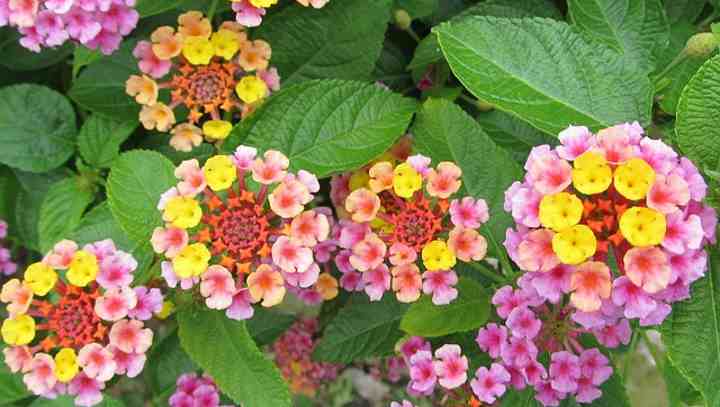
Texas lantana is a colorful and versatile flowering plant native to Texas. It’s identified by its clusters of bright, multi-colored tubular flowers. The small round flowerheads range in color from yellow and orange to red and purple. The aromatic lanceolate leaves have a rough texture and emit a pungent scent when crushed.
Texas lantana shrubs are drought-tolerant and thrive in hot and dry conditions—ideal for Texas landscapes. You can plant lantanas in flower beds, borders, coastal gardens, or containers. The low-growing shrub also works well as an evergreen full-sun ground cover. Texas lantana is low-maintenance and blooms throughout the year in warm climates, adding a burst of color to any garden.
It’s good to note that the purple-black berries on lantana shrubs are poisonous to humans and wildlife.
USDA Zone: 8 to 11
Sun: Full sun
Soil: Various soil types that are well-drained
Height: 2 to 3 ft. (0.6 – 1 m) tall and wide
Gulf Coast Muhly (Muhlenbergia capillaris)

Gulf Coast muhly is a spectacular ornamental native grass known for its stunning pink or purple plume-like flowers. This sun-loving ornamental grass blooms in late summer and early fall, creating beautiful cloud-like floral displays. The feathery flowers sway in the breeze, adding movement and texture to the landscape.
Gulf Coast muhly is a versatile native plant that thrives in the heat, sun, and arid conditions of Texas. Landscaping uses for this decorative grass include beds and borders, coastal gardens, rock gardens, or adding color and texture to a foundation planting. The grass keeps its beautiful pink colors throughout winter.
USDA Zone: 6 to 11
Sun: Full sun
Soil: Rocky, sandy, dry soils with medium moisture and good drainage
Height: 2 to 3 ft. (0.6 – 1 m) tall and wide
Flame Acanthus (Anisacanthus quadrifidus var. wrightii)
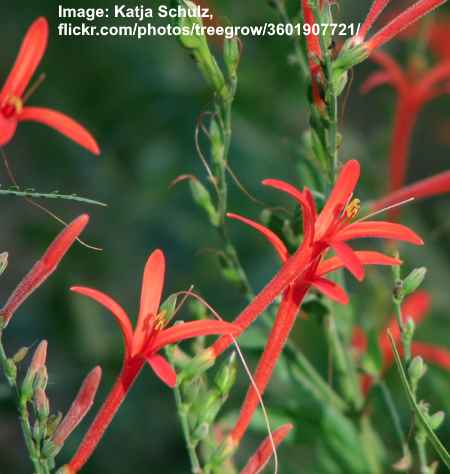
Native to Texas, flame acanthus is a vibrant and drought-tolerant perennial shrub. The ornamental plant is identified by fiery red tubular flowers that bloom throughout summer until fall, adding a burst of color to any southern garden or landscape. The red flowers contrast with the small lance-shaped leaves on long, slender stems.
Flame acanthus attracts native wildlife like hummingbirds, butterflies, and bees. This heat-loving plant is perfect for xeriscaping and thrives in hot, dry conditions. You can grow the red-flowering shrub as a hedge or perennial border plant or add a splash of red colors to rock gardens.
USDA Zone: 7 to 10
Sun: Full sun or partial shade
Soil: Medium to dry soils that drain well
Height: 3 to 5 ft. (0.9 – 1.5 m) tall and wide
Blackfoot Daisy (Melampodium leucanthum)
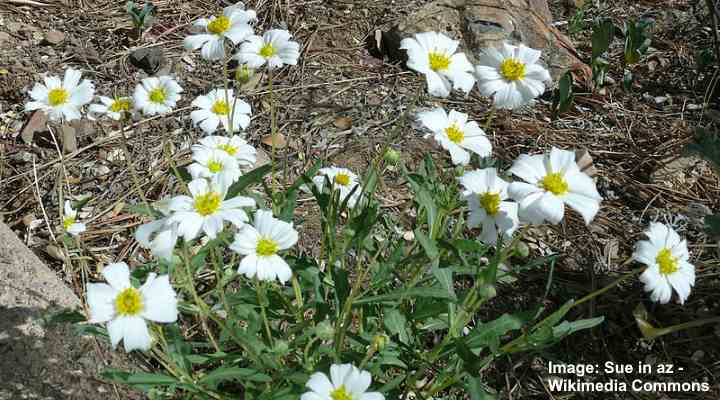
Blackfoot daisy is a small, perennial Texas wildflower with a long blooming season. It is characterized by its delicate white daisy-like flowers with yellow centers. The flowers bloom from spring to fall, creating a carpet of white in landscapes. The low-growing plant has gray-green foliage and a compact, mounding habit.
Blackfoot daisies are drought-tolerant and thrive in the hot, dry conditions of the deep South. The landscaping flowers are ideal for enhancing rock gardens, borders, and containers. The low-maintenance wildflower attracts butterflies and bees, making them an important addition to gardens in Texas.
USDA Zone: 6 to 10
Sun: Full sun or partial shade
Soil: Sandy, gravelly, rocky soils that have excellent drainage
Height: 6” to 12” (15 – 30 cm) tall and 12” to 24” (30 – 60 cm) wide
Mexican Feathergrass (Nassella tenuissima)
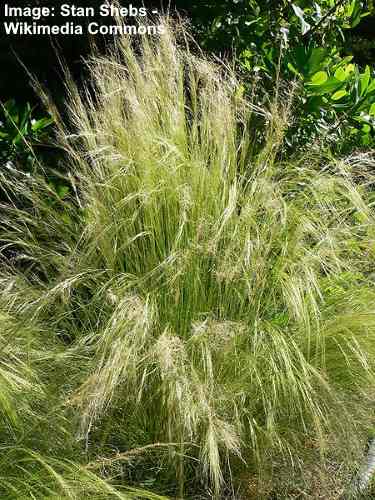
Mexican feathergrass is a popular ornamental grass native to Texas and New Mexico. The grass is known for its delicate and wispy appearance, with thread-like green blades that sway gracefully in the wind. In late spring and early summer, the grass blooms with feathery flower spikes that add texture and visual interest to landscapes.
This hardy, deciduous grass forms dense, fountain-like clumps in full sun conditions. Thanks to its heat, sun, and drought tolerance, it’s a great addition to xeriscapes and low-maintenance gardens. Additionally, you can plant Mexican feathergrass in mass plantings, borders, or as a focal point. Mexican feathergrass is also a favorite among gardeners because it attracts butterflies and other pollinators.
USDA Zone: 7 to 11
Sun: Full sun
Soil: Well-drained, moderately fertile soils
Height: 1 to 2 ft. (0.3 – 0.6 m) tall and wide
Plateau Goldeneye (Viguiera dentata)

Also known as sunflower goldeneye, this perennial wildflower is native to Texas. The bushy, multi-branched plant is known for its bright yellow, daisy-like flowers with dark centers blooming on leafless stalks. Blooming from late spring to fall, the goldeneye flowers attract pollinators such as bees and butterflies.
Plateau goldeneye tolerates drought, shade, and heat, making it a great addition to Texas landscapes. You can plant the yellow-flowering -perennial plant in rock gardens or naturalized areas. The fast-growing plant fills landscapes with gray-green foliage and bursts into color after the rains in August and September.
USDA Zone: 7 to 10
Sun: Partial shade to full shade
Soil: Various types of well-drained soils
Height: 3 to 6 ft. (1 – 1.8 m) tall and wide
Purple Coneflower (Echinacea purpurea)

Purple coneflower is a tall perennial flower that thrives in Texas and southern landscapes. The flowering herbaceous plant is characterized by its vibrant purple petals drooping around and dark brown cone-shaped center. Lance-shaped dark green leaves grow on tall, erect stems. Blooming all summer, the flowers attract butterflies and bees to the garden.
Purple coneflower is a versatile plant for hot, sunny landscapes. The eye-catching purple flowers look stunning when grown en masse in perennial borders. You can also use purple coneflowers in landscapes to add height and texture to flower beds, borders, or wildflower gardens. The hardy native plant tolerates drought, heat, and humidity, making it an ideal addition to Texas landscapes.
USDA Zone: 3 to 8
Sun: Full sun
Soil: Well-drained soils
Height: 2 to 5 ft. (0.6 – 1.5 m) tall and up to 2 ft. (0.3 – 0.6 m) wide
Black Dalea (Dalea frutescens)

Native to Texas and Oklahoma, black dalea is a perennial flowering shrub identified by its small, purple flowers and pinnate compound leaves. The dainty purple flower clusters bloom from July to October, complementing the bushy foliage. This low-growing plant has a spreading habit, making it ideal for ground cover with purple flowers or as a garden border plant.
Black dalea is well-suited to Texas landscapes due to its tolerance for drought and heat. You can plant the flowering ground cover shrub in xeriscapes and water-wise gardens. Additionally, its foliage of fern-like leaves adds texture to the landscape.
USDA Zone: 9 to 13
Sun: Full sun
Soil: Moist, rich, or sandy soils that have excellent drainage
Height: 2 to 3 ft. (0.6 – 1 m) tall and wide
Texas Betony (Stachys coccinea)

Also known as scarlet hedgenettle, Texas betony is an herbaceous native plant. The ground-hugging, spreading perennial is known for its vibrant red tubular flowers blooming in late spring through summer. These red flowers contrast with the plant’s fuzzy dark-green leaves. The flowers attract bees, butterflies, and hummingbirds, making them a great addition to Texas gardens.
Texas betony is a low-maintenance plant that thrives in partial shade. Landscaping uses for this Texas native include border plantings, rock gardens, or as a ground cover in the shade. Its attractive foliage and colorful flowers add a pop of color to any landscape.
USDA Zone: 7 to 9
Sun: Partial shade
Soil: Most soils that have excellent drainage
Height: Up to 3 ft. (1 m) tall and wide
Winecup (Callirhoe involucrata)
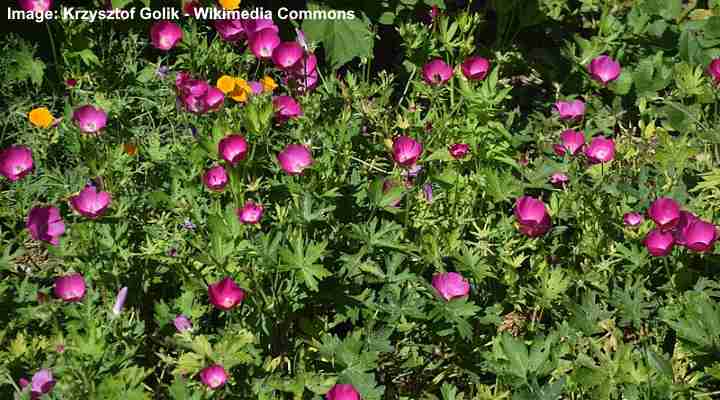
Winecup—also known as purple poppy mallow—is a wildflower native to Texas. The characteristic feature of the plant is its stunning cup-shaped deep red or magenta flowers. These upward-facing blossoms bloom in vibrant shades of pink, purple, and occasionally white. The magenta bowl-shaped flowers open in the morning and close in the evening.
Winecup flowers bloom from spring through summer. When in bloom, the ground-hugging plant creates a colorful mat of dark pink or red flowers that attract butterflies and hummingbirds. Apart from full-sun ground cover, you can grow winecup flowers in border fronts, trail over a wall, or enhance rock gardens.
USDA Zone: 4 to 8
Sun: Full sun
Soil: Dry to medium well-drained soils
Height: 6” to 12” (15 – 30 cm) tall and 3 ft. (1 m) wide
Copper Canyon Daisy (Tagetes lemmonii)

Copper Canyon daisy is a stunning yellow-flowering plant native to Arizona. Also known as shrub marigold, this heat-hardy perennial flowering plant blooms with masses of bright yellow daisy-like flowers and aromatic foliage. The flowers bloom in late fall, adding a burst of color to gardens when most plants have finished flowering.
Copper Canyon daisy is a versatile plant for foundation planting, a low hedge, or shrub borders. The brightly colored yellow flowers attract butterflies and pollinators to southern gardens.
USDA Zone: 8 to 11
Sun: Full sun or partial shade
Soil: Well-drained soils
Height: 4 to 6 ft. (1.2 – 1.8 m) tall and 6 to 10 ft. (1.8 – 3 m) wide
Texas Indian Paintbrush (Castilleja indivisa)
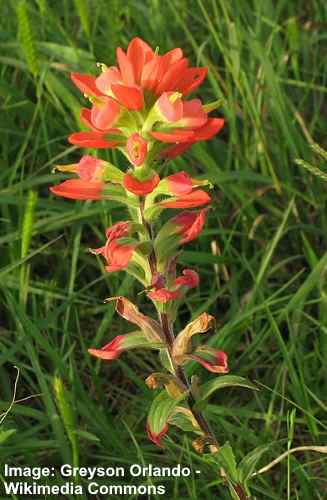
Texas Indian paintbrush is an iconic Texas native wildflower characterized by showy vibrant red-orange flower clusters. Blooming in spring, small Texas paintbrush flowers are surrounded by petal-like bracts that make them resemble paintbrushes. The colorful flowers bloom atop and grace Texas landscapes together with the Texas state flower—bluebonnets.
Texas Indian paintbrush flowers are ideal for adding a splash of color to informal gardens, foundation plantings, fence lines, and mixed beds. They are also vital nectar sources for pollinators, attracting bees, butterflies, and hummingbirds.
USDA Zone: 6 to 11
Sun: Full sun
Soil: Sandy, loamy, or clay soils that drain well
Height: 0.5 to 2 ft. (0.15 – 0.6 m) tall and wide
Texas Sotol (Dasylirion texanum)

Texas sotol is a striking desert plant native to Texas. This heat-loving grass-like plant is identified by its long, narrow bluish-green leaves that grow in a rosette form. Like a yucca plant, the Texas sotol pointed leaves have sharp edges. It produces a long 15 ft. (4.5 m) flower stalk with clusters of small yellowish-white flowers.
Texas sotol is a tough and drought-tolerant plant that thrives in the arid conditions of Texas. You can use Texas sotol in xeriscaping, rock gardens, or as a tough security hedge. It is important to note that Texas sotol is a slow-growing plant and can take several years to reach its full size.
USDA Zone: 5 to 9
Sun: Full sun
Soil: Well-drained sandy or rocky soils
Height: 3 to 6 ft. (0.9 – 1.8 m) tall and 4 to 6 ft. (1.2 – 1.8 m) wide
Mexican Hat (Ratibida columnifera)

Mexican hat is a fast-growing wildflower native to Texas that adds interest to sunny landscapes. The unusual flower is identified by its drooping yellow and rusty-red drooping petals surrounding a prominent cone-shaped center. The tall upright stems also have slender feathery leaves with a deep cleft in the center.
Drought-tolerant and sun-loving, the Mexican hat thrives throughout Texas. Its distinctive flowers look stunning in sunny borders, cottage gardens, or mass plantings. They also attract wildlife like bees and butterflies for nectar and birds in the fall and winter for seeds.
USDA Zone: 4 to 9
Sun: Full sun
Soil: All types of well-drained soils
Height: 1 to 3 ft. (0.3 – 1 m) tall and 1 to 2 ft. (0.3 – 0.6 m) wide
Texas Star Hibiscus (Hibiscus coccineus)
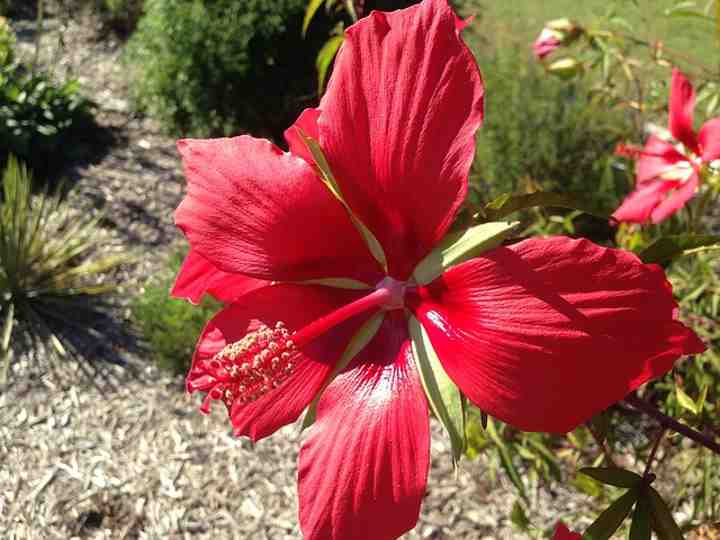
Also known as scarlet rose mallow, Texas star hibiscus is a striking red-flowering plant native to Texas. The heat-hardy perennial is known for its large, showy red flowers with five petals resembling a star. These vibrant flowers bloom from summer to fall, and the native plant has attractive palmate dark-green leaves.
Texas star hibiscus is ideal for adding height and color to sunny garden borders or foundation lines. Its tolerance for wet soil means you can also grow the hibiscus plant in rain gardens, bog gardens, or beside ponds. The Texas Star Hibiscus is a low-maintenance plant that adds a tropical touch to any landscape.
USDA Zone: 6 to 9
Sun: Full sun or partial shade
Soil: Moist to wet, well-drained soils
Height: 3 to 6 ft. (1 – 1.8 m) tall and 2 to 3 ft. (0.6 – 1 m) wide
Dotted Blazing Star (Liatris punctata)
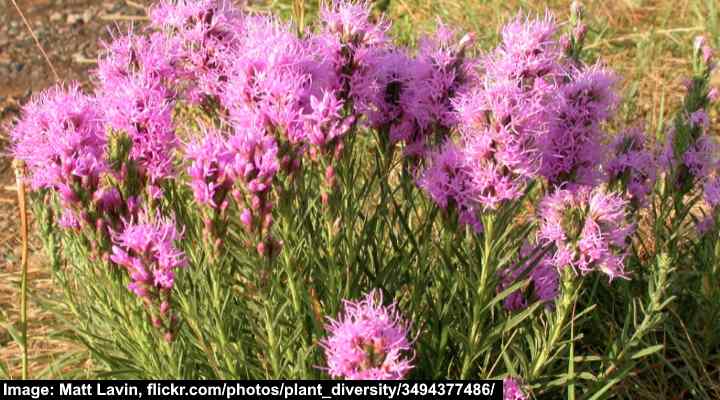
Native to Texas, dotted blazing star is a perennial wildflower native to Texas. The flowering plant has eye-catching cylindrical clusters of small, tubular flowers that are pale pink to lavender or purple. The flowering spikes have numerous protruding stamens, giving it a feathery appearance resembling bottlebrushes.
Drought-tolerant dotted blazing star is a great addition to Texan gardens and landscapes. The wildflower thrives in perennial borders, native plant gardens, and xeriscape or water-efficient landscapes. This low-maintenance plant is great for incorporating native plants into landscapes to support local wildlife.
USDA Zone: 4 to 9
Sun: Full sun
Soil: Dry to moist, well-drained soils
Height: 1 to 2 ft. (0.3 – 0.6 m) tall and 1 ft. (0.3 m) wide
Flameleaf Sumac (Rhus lanceolata)
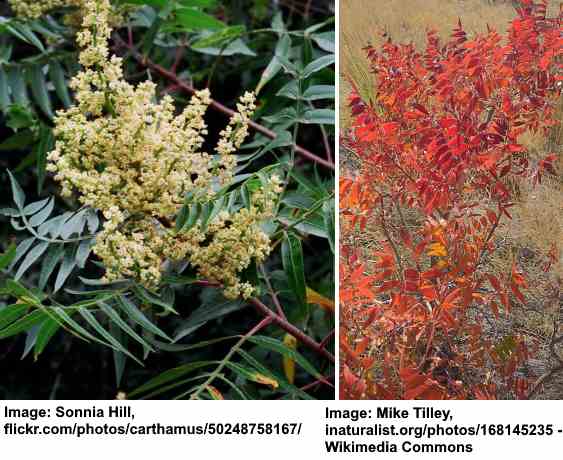
Flameleaf sumac is a deciduous ornamental tree native to western Texas. The attractive, fast-growing tree is known for its vibrant fall foliage of red and orange colors. Additionally, the flameleaf sumac blooms with pyramidal clusters of small creamy-white flowers followed by bright red berries.
Flameleaf sumac is drought, cold, and heat-tolerant, making it a useful addition to Texas landscapes. You can plant the small decorative tree as a windbreak, natural screen, or specimen tree. Its colorful fall colors, attractive flowers, and clusters of berries give the plant visual appeal throughout most seasons.
USDA Zone: 6 to 9
Sun: Full sun
Soil: Well-drained clay, loamy, or sandy soils
Height: Up to 30 ft. (10 m) tall
American Beautyberry (Callicarpa americana)
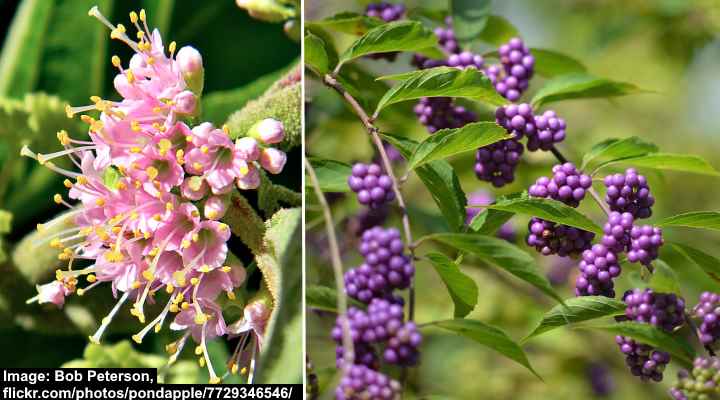
American beautyberry is a deciduous shrub native to the southeastern United States, including Texas. The sun-loving shrub is known for its clusters of vibrant purple to bluish-purple berries that cover branches in the fall. Additionally, the beautyberry shrub has clusters of spring-blooming blue, pink, or white flowers and ovate leaves that turn golden yellow in the fall.
The beautyberry shrub is a great addition to southern gardens and landscapes, adding color and interest. The colorful shrub with its magenta berries performs well as a border plant, in mass plantings, or as a focal point in the garden. Its tolerance to damp conditions makes it perfect for planting beside a pond or stream.
USDA Zone: 6 to 10
Sun: Partial shade to full sun
Soil: Moist, well-drained soils; tolerates some drought
Height: 3 to 8 ft. (1 – 2.4 m) tall and 3 to 6 ft. (1 – 1.8 m) wide
Texas Bluebell (Eustoma grandiflorum)
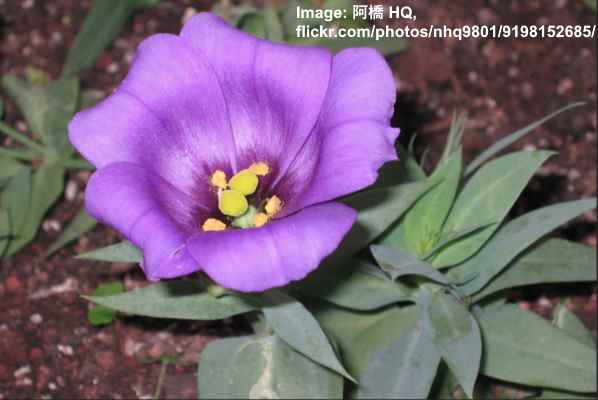
Texas bluebell is a beautiful purple-flowering plant native to Texas. The bell-shaped flowers bloom in shades of blue, purple, pink, or white. Producing flowers in late spring and summer, the eye-catching tubular flowers add a pop of bright color to gardens and landscapes.
Texas bluebells are popular for planting in borders, mixed beds, or edging. Additionally, they grow well in containers to brighten a deck area, patio, or balcony. The blue and purple nectar-rich flowers attract hummingbirds and pollinators.
USDA Zone: 8 to 10
Sun: Full sun or partial shade
Soil: Well-drained soils
Height: 1 to 3 ft. (0.3 – 1 m) tall and 1 ft. (0.3 m) wide
Texas Yucca (Yucca rupicola)
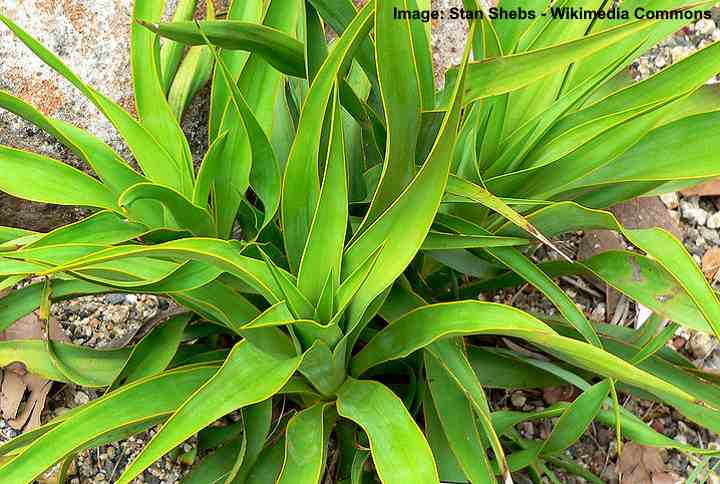
Texas yucca, also known as twisted-leaf yucca, is a drought-tolerant plant native to Texas. This unique flowering desert plant is identified by its slender, twisting leaves forming a rosette shape close to the ground. In the spring, tall 5 ft. (1.5 m) stalks of creamy white flowers emerge, creating a striking display.
Texas yucca is a tough and resilient plant that thrives in hot and dry conditions. It is well-suited for xeriscaping and can be used in rock gardens, desert landscapes, or as a focal point in a container. This low-maintenance plant requires little water and can withstand extreme temperatures.
USDA Zone: 7 to 10
Sun: Full sun
Soil: Rocky, sandy, well-drained soils
Height: 2 ft. (0.6 m) tall not in bloom and 6 ft. (1.8 m) in bloom
Golden Tickseed (Coreopsis tinctoria var. tinctoria)

Golden tickseed is a wildflower native to Texas with bright yellow flowers that bloom in early summer. Tickseed flowers are identified by their golden yellow petals with dark brown or red centers. These daisy-like yellow flowers bloom on the top of slender, stiff stalks. The plant’s feathery foliage adds to its landscaping appeal.
Blooming throughout summer in sunny conditions, golden tickseed is perfect for hot, arid climates. This versatile plant thrives in wildflower gardens, naturalized areas, and borders. In addition, the brightly colored yellow and red flowers look stunning in mass plantings where they bloom for a long time in summer heat and humidity.
USDA Zone: 2 to 11
Sun: Full sun
Soil: Dry to medium moisture, rocky, poor, or sandy, well-drained soils
Height: 2 to 4 ft. (0.6 – 1.2 m) tall and 2 ft. (0.6 m) wide
Butterfly Weed (Asclepias tuberosa)

Butterfly weed is a perennial wildflower native to the southern United States. The easy-care, drought-tolerant plant is known for its stunning clusters of vibrant orange flowers. The flat-topped flower clusters and stiff lanceolate leaves create textures and visual appeal in Texan garden landscapes. They also attract butterflies and other pollinators.
The bright orange flowers of butterfly weed bloom in the summer and are clustered at the top of the plant. The flowers are a nectar source for many butterfly species, including monarch butterflies. Butterfly weed is drought-tolerant and can withstand hot Texas summers. This vigorous perennial adds aesthetic value to beds, borders, and cottage gardens.
USDA Zone: 3 to 9
Sun: Full sun
Soil: Dry to medium moisture, well-drained soils
Height: 1 to 2 ft. (0.3 – 0.6 m) tall and wide
Rock Rose (Pavonia lasiopetala)
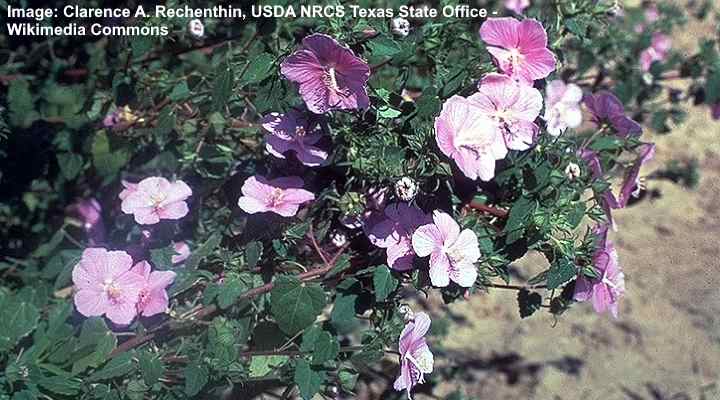
Rock rose is a native Texas perennial shrub known for its attractive pink flowers. The pink or rose-colored flowers resemble small hibiscus blooms with five papery petals and a protruding stamen. Blooming from spring to fall, the large flowers attract butterflies and hummingbirds to the gardens throughout the Lone Star State.
Rock rose is a versatile plant used in various landscape settings. You can grow the shrubby plant in flower beds, borders, foundation plantings, and rock gardens. Its ability to withstand extreme heat and drought makes it a valuable addition for enhancing beauty in Texas gardens.
USDA Zone: 9 to 13
Sun: Full sun or partial shade
Soil: Well-drained loamy, sandy, or clay soils
Height: 2 to 4 ft. (0.6 – 1.2 m) tall and wide
Texas Yellow Star (Lindheimera texana)

Texas yellow star (or Texas yellowstar) is a native Texas wildflower prized for its bright yellow ray flowers. Like daisy flowers, the yellow star flowers are five-petalled, star-shaped flowers blooming at the end of stems in spring. Additionally, the widely branched plant has leathery, dark-green leaves.
Native Texas yellow star flowers perform well in sunny landscapes as ground cover or in rock gardens. Their yellow and green colors, as well as their drought, sun, and heat tolerance, make them perfect for adding a pop of color and texture to southern landscapes.
USDA Zone: 9 to 11
Sun: Full sun
Soil: Well-drained soils
Height: 1 to 2 ft. (0.3 – 0.6 m) tall and wide
Texas Persimmon (Diospyros texana)
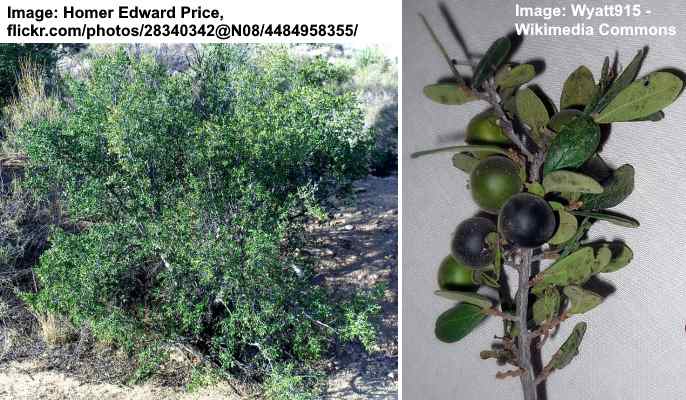
Texas persimmon is a small, deciduous tree native to Texas prized for its tasty black berries. The small tree produces white urn-shaped flowers, obovate, dark-green leaves, and small, blackish-purple fruit that resembles a plum. The natural habitat of Texas persimmon is in southwest Texas and northern Mexico.
Texas persimmon is an extremely drought-tolerant tree that thrives in the hot, dry conditions of Texas. Its attractive foliage, white flowers, black berries, and appealing shape give the tree tremendous ornamental value. South of the Rio Grande Valley, the tree’s foliage is semi-evergreen. In Northern Texas, the foliage turns yellow in the fall before the leaves drop.
USDA Zone: 7 to 10
Sun: Full sun or partial shade
Soil: Well-drained limestone, loam, and clay soils
Height: 20 to 40 ft. (6 – 12 m) tall and 25 ft. (7.6 m) wide
Trumpet Creeper (Campsis radicans)
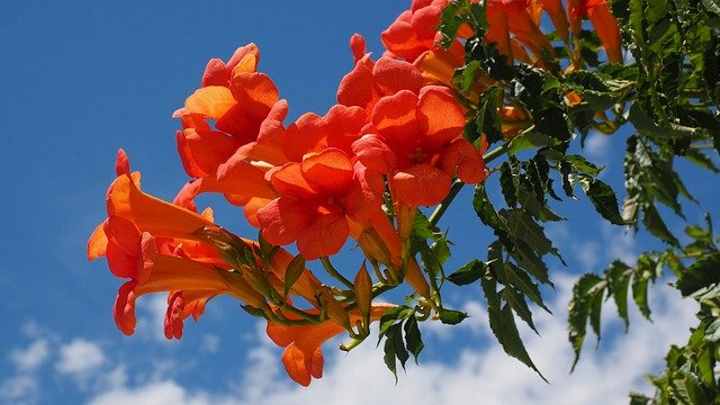
Trumpet creeper is a vigorous, self-clinging vine native to eastern Texas. The vine’s showy flowers are trumpet-shaped, orange-red blooms that appear throughout summer. The masses of orange tubular flowers are followed by attractive seed pods. The Texas vining plant also has small pinnate leaves growing densely on scrambling stems.
This fast-growing vine is perfect for climbing or scrambling over fences, trellises, or arbors. Without support, the spreading stems and orange flowers grow as full-sun ground cover in semi-tropical landscapes. The vigorous vine can tolerate drought, heat, and cold conditions.
USDA Zone: 4 to 9
Sun: Full sun or partial shade
Soil: Moist, well-drained soils
Height: 20 to 40 ft. (6 – 12 m) tall and up to 10 ft. (3 m) wide
Eastern Red Columbine (Aquilegia canadensis)
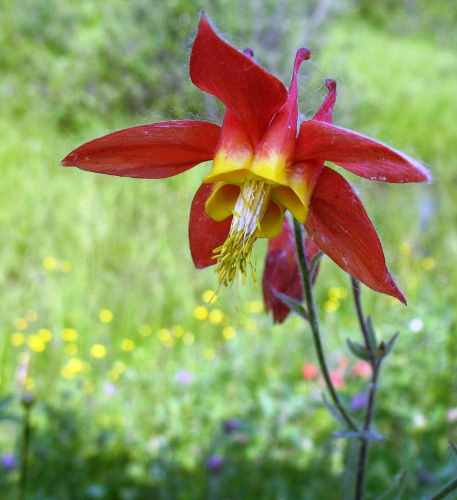
Eastern red columbine is a native perennial wildflower that adds color to Texas landscapes. This native Texas flower is known for its unique red and yellow bell-shaped flowers that nod at the end of slender stems. The dainty red flowers resemble a bird in flight and bloom from late spring through summer. Additionally, the plants have attractive fern-like foliage.
Eastern red columbine is a versatile plant that grows easily in beds, borders, and pathway edges. Thanks to its shade tolerance, you can also use these flowers for underplanting roses and shrubs to increase aesthetic value in your front or backyard. The delicate foliage adds an attractive touch to any landscape, and the flowers make beautiful additions to cut flower arrangements.
USDA Zone: 3 to 8
Sun: Partial shade
Soil: Moist, well-drained soils in partially shaded conditions
Height: 2 to 3 ft. (0.6 – 1 m) tall and 1 to 2 ft. (0.3 – 0.6 m) wide
Texas Thistle (Cirsium texanum)
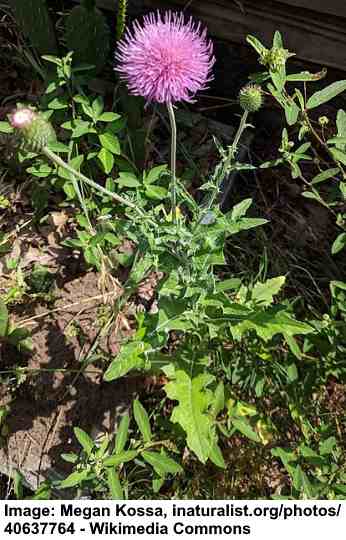
Texas thistle is a native wildflower in Texas that is known for its spiky purple flowers and sharp, spiny stiff leaves. The native thistle plant is a biennial, meaning it takes two years to complete its life cycle. In the first year, the plant grows a rosette of spiky leaves close to the ground. In the second year, it sends up a tall stalk with purple flowers that attract pollinators.
Texas thistle is an important plant for wildlife in native habitats as it provides nectar for bees, butterflies, and other pollinators. The jaggy plant blooms early in summer. Texas thistle is an ideal plant for naturalizing a meadow or prairie landscape, and can also be used as a border plant or planted in mass for a stunning display of color.
USDA Zone: 6 to 10
Sun: Full sun
Soil: Well-draining dry soils
Height: 2 to 6 ft. (0.6 – 1.8 m) tall
Crossvine (Bignonia capreolata)
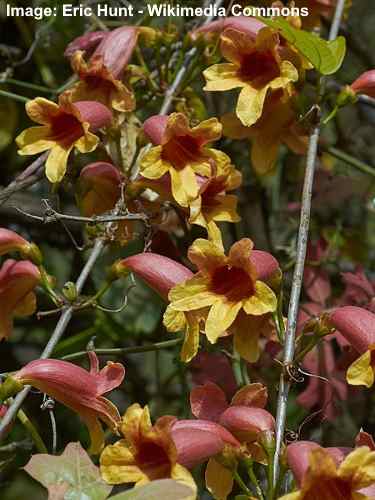
Crossvine is a vigorous climbing vine known for its eye-catching, trumpet-shaped orange and yellow flowers. Native to Texas, the woody vine blooms in spring and summer with funnel-like flowers in orange, red, and yellow shades. These add a burst of color to landscapes. The foliage is glossy and dark green, providing an attractive backdrop for the flowers.
This fast-growing vine is perfect for covering fences, trellises, or arbors with attractive foliage and showy flowers. It can also be used as a ground cover or to create a natural screen. Crossvine is a low-maintenance plant that is drought-tolerant and attracts hummingbirds and butterflies.
USDA Zone: 6 to 9
Sun: Full sun or partial shade
Soil: Organically rich, well-drained soils
Height: 30 to 50 ft. (9 – 15 m) tall and spread up to 9 ft. (2.7 m)
Dwarf palmetto (Sabal minor)
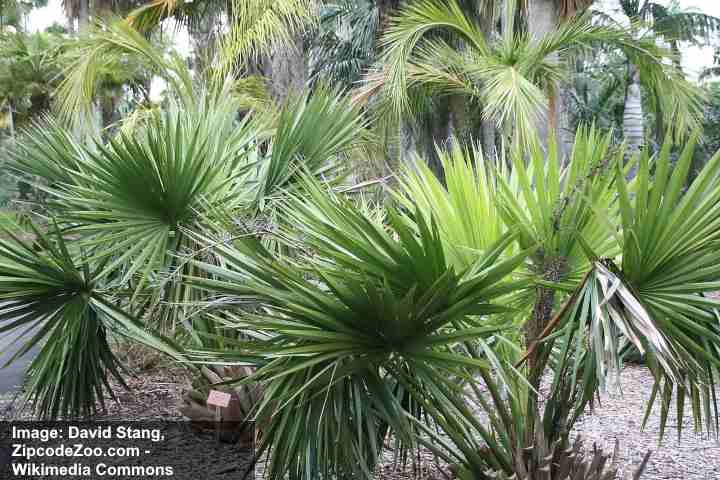
If you are looking for a small palm to landscape a Texas landscape, the dwarf palmetto is an excellent choice. Native to the southeast, this palm tree is identified by its fan-shaped leaves, clusters of creamy-white flowers, and small, black palm fruits. The slow-growing, hardy evergreen adds a tropical touch to southern landscapes.
Dwarf palmetto is a versatile plant to add texture to a tropical landscape. The stunning foliage adds visual appeal to foundation plantings or creates a textural accent. It is drought-tolerant and thrives in full sun and partial shade. Its compact size makes it suitable for small gardens or containers.
USDA Zone: 7 to 10
Sun: Full sun or partial shade
Soil: Moderately fertile, moist, well-drained soils
Height: 4 to 6 ft. (1.2 – 1.8 m) tall and wide
Fleabane (Erigeron philadelphicus)
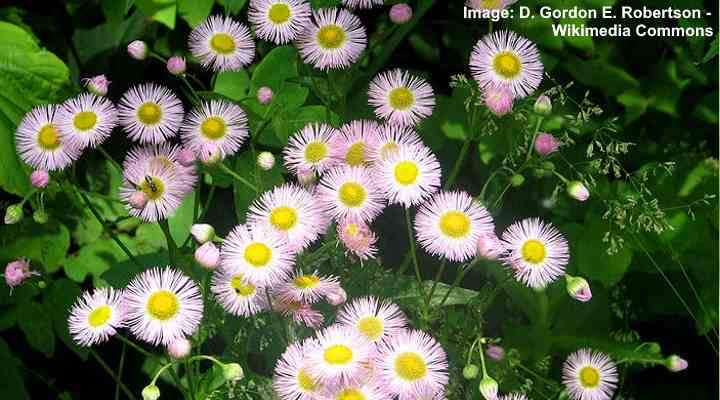
Fleabane is a native wildflower found growing naturally throughout Texas. This perennial plant is known for its clusters of small aster-like flowers that bloom in mid-spring through summer. The attractive ray flowers, with a yellow center disk, can be white, pink, or purple. The blooms appear atop upright, fuzzy stems that have spatula-shaped leaves.
Fleabane thrives in various conditions in hot Texan landscapes, including full sun or partial shade. The colorful daisy-like flowers are a great addition to flower borders, butterfly gardens, and rock gardens. You can also plant the flowers in containers to brighten a balcony or patio.
USDA Zone: 2 to 7
Sun: Full sun or light shade
Soil: Dry to medium well-drained soils
Height: 1 to 3 ft. (0.3 – 0.9 m) tall and 1 ft. (0.3 m) wide
Damianita (Chrysactinia mexicana)
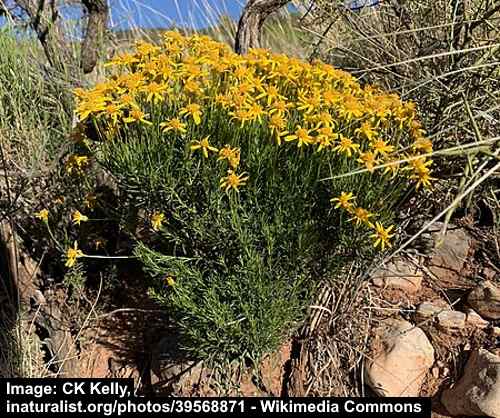
Damianita is a small evergreen shrub native to Texas prized for its masses of star-shaped yellow flowers. The bright golden-yellow ray flowers face upward at the top of slender stems. The plant has bushy mounds of slender dark-green leaves that are aromatic when crushed. Blooming profusely from spring through fall, damianita creates a carpet of bright yellow colors.
This drought-tolerant plant is perfect for xeriscaping and can thrive in hot, dry conditions. It is also deer resistant, making it a great choice for gardens in rural settings. Additionally, damianita performs well in rock gardens, borders, and containers. You can also grow it as a yellow-flowering ground cover for full sun.
USDA Zone: 7 to 11
Sun: Full sun
Soil: Well-drained soils
Height: 1 to 2 ft. (0.3 – 0.6 m) tall and wide
Desert willow (Chilopsis linearis)
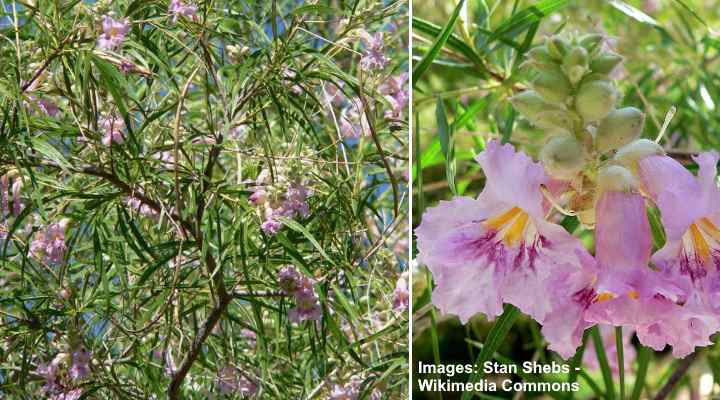
Desert willow is a small to medium-sized deciduous tree native to many parts of Texas. Identifying features of the ornamental tree are its willow-like leaves, stunning trumpet-shaped fragrant flowers, shaggy bark, and bean-like seed pods. The tree blooms in spring with showy flower clusters of pale pink to violet blossoms. These fragrant flowers bloom through summer and fall, attracting pollinators like hummingbirds and butterflies.
This fast-growing, drought-tolerant tree is perfect for hot and dry climates, making it a popular choice for Texas landscapes. You can plant desert willow as a specimen tree or erosion control in arid Texan landscapes. Its compact size means it is an excellent shade tree in smaller yards.
USDA Zone: 7 to 11
Sun: Full sun
Soil: Well-drained soils
Height: 15 to 30 ft. (4.5 – 9 m) tall and 10 to 20 ft. (3 – 6 m) wide
Related articles:
